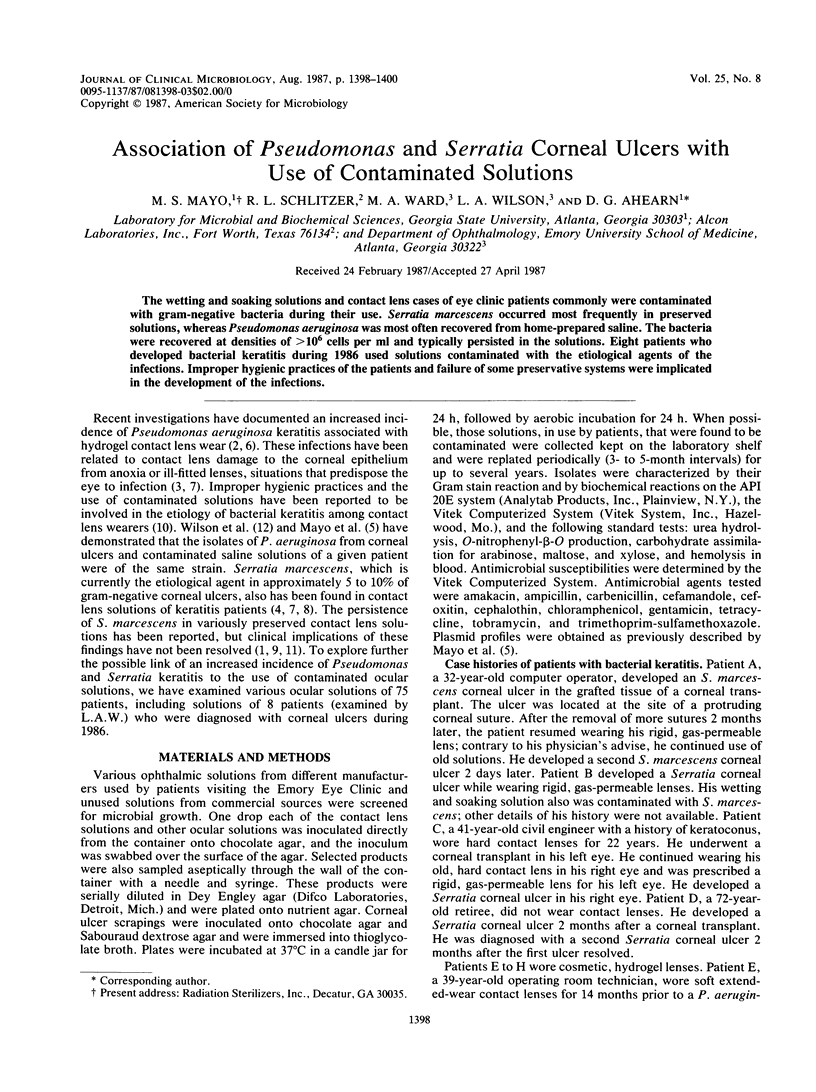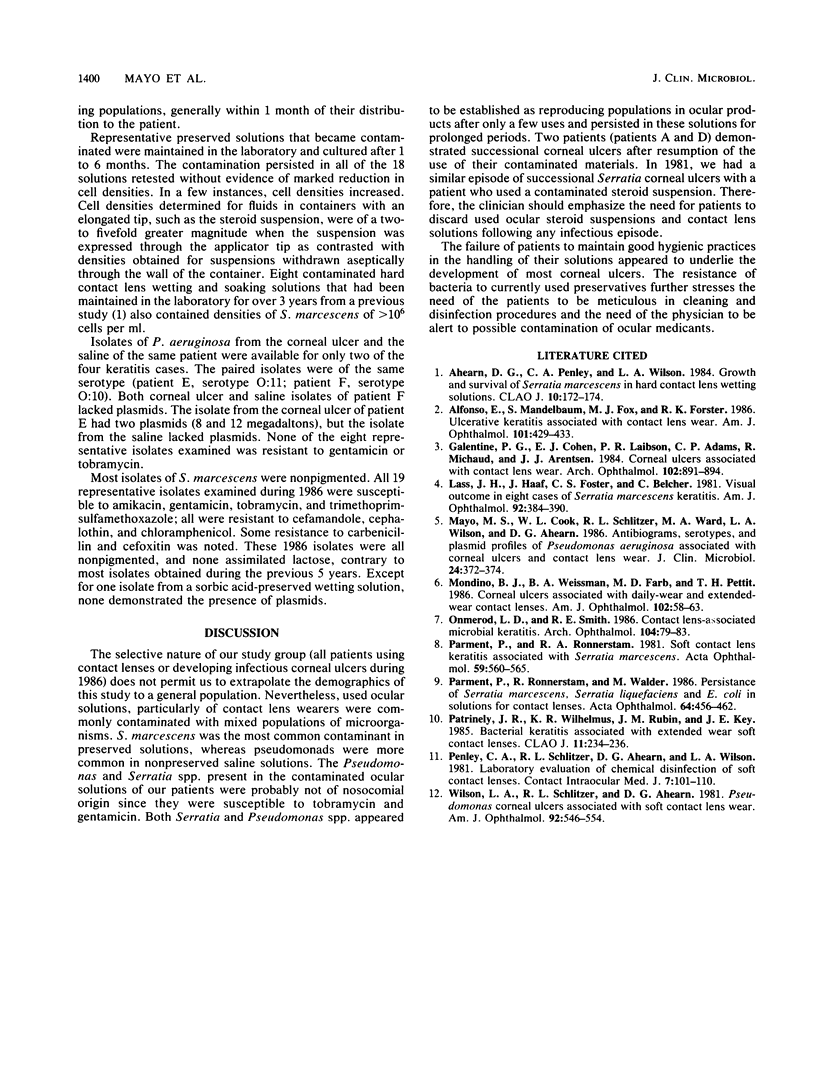Abstract
The wetting and soaking solutions and contact lens cases of eye clinic patients commonly were contaminated with gram-negative bacteria during their use. Serratia marcescens occurred most frequently in preserved solutions, whereas Pseudomonas aeruginosa was most often recovered from home-prepared saline. The bacteria were recovered at densities of greater than 10(6) cells per ml and typically persisted in the solutions. Eight patients who developed bacterial keratitis during 1986 used solutions contaminated with the etiological agents of the infections. Improper hygienic practices of the patients and failure of some preservative systems were implicated in the development of the infections.
Full text
PDF


Selected References
These references are in PubMed. This may not be the complete list of references from this article.
- Ahearn D. G., Penley C. A., Wilson L. A. Growth and survival of Serratia marcescens in hard contact lens wetting solutions. CLAO J. 1984 Apr-Jun;10(2):172–174. [PubMed] [Google Scholar]
- Alfonso E., Mandelbaum S., Fox M. J., Forster R. K. Ulcerative keratitis associated with contact lens wear. Am J Ophthalmol. 1986 Apr 15;101(4):429–433. doi: 10.1016/0002-9394(86)90641-0. [DOI] [PubMed] [Google Scholar]
- Galentine P. G., Cohen E. J., Laibson P. R., Adams C. P., Michaud R., Arentsen J. J. Corneal ulcers associated with contact lens wear. Arch Ophthalmol. 1984 Jun;102(6):891–894. doi: 10.1001/archopht.1984.01040030711025. [DOI] [PubMed] [Google Scholar]
- Lass J. H., Haaf J., Foster C. S., Belcher C. Visual outcome in eight cases of Serratia marcescens keratitis. Am J Ophthalmol. 1981 Sep;92(3):384–390. doi: 10.1016/0002-9394(81)90529-8. [DOI] [PubMed] [Google Scholar]
- Mayo M. S., Cook W. L., Schlitzer R. L., Ward M. A., Wilson L. A., Ahearn D. G. Antibiograms, serotypes, and plasmid profiles of Pseudomonas aeruginosa associated with corneal ulcers and contact lens wear. J Clin Microbiol. 1986 Sep;24(3):372–376. doi: 10.1128/jcm.24.3.372-376.1986. [DOI] [PMC free article] [PubMed] [Google Scholar]
- Mondino B. J., Weissman B. A., Farb M. D., Pettit T. H. Corneal ulcers associated with daily-wear and extended-wear contact lenses. Am J Ophthalmol. 1986 Jul 15;102(1):58–65. doi: 10.1016/0002-9394(86)90210-2. [DOI] [PubMed] [Google Scholar]
- Ormerod L. D., Smith R. E. Contact lens-associated microbial keratitis. Arch Ophthalmol. 1986 Jan;104(1):79–83. doi: 10.1001/archopht.1986.01050130089027. [DOI] [PubMed] [Google Scholar]
- Parment P. A., Rönnerstam R. A. Soft contact lens keratitis associated with Serratia marcescens. Acta Ophthalmol (Copenh) 1981 Aug;59(4):560–565. doi: 10.1111/j.1755-3768.1981.tb08343.x. [DOI] [PubMed] [Google Scholar]
- Parment P. A., Rönnerstam R., Walder M. Persistence of Serratia marcescens, Serratia liquefaciens and E. coli in solutions for contact lenses. Acta Ophthalmol (Copenh) 1986 Aug;64(4):456–462. doi: 10.1111/j.1755-3768.1986.tb06953.x. [DOI] [PubMed] [Google Scholar]
- Patrinely J. R., Wilhelmus K. R., Rubin J. M., Key J. E., 2nd Bacterial keratitis associated with extended wear soft contact lenses. CLAO J. 1985 Jul-Sep;11(3):234–236. [PubMed] [Google Scholar]
- Penley C. A., Schlitzer R. L., Ahearn D. G., Wilson L. A. Laboratory evaluation of chemical disinfection of soft contact lenses. Contact Intraocul Lens Med J. 1981 Apr-Jun;7(2):101–110. [PubMed] [Google Scholar]
- Wilson L. A., Schlitzer R. L., Ahearn D. G. Pseudomonas corneal ulcers associated with soft contact-lens wear. Am J Ophthalmol. 1981 Oct;92(4):546–554. doi: 10.1016/0002-9394(81)90649-8. [DOI] [PubMed] [Google Scholar]


